There are numerous facets to managing a supermarket, but inventory management is one of the most crucial. Product placement greatly impacts how happy customers are with your business and how it runs. The customer experience and purchase team concerns are the two primary areas of emphasis in this book, which will assist you in understanding the best practices for inventory placement in your supermarket.
The customer’s experience is at the heart of any successful supermarket. How you arrange your inventory plays a big role in shaping this experience. Let’s look at the key factors to consider:
Easy Navigation
The layout of your store should prioritize customer movement and ease of navigation. Aisles should be spacious, typically around 8 feet wide or more in high-traffic areas, allowing shopping carts to pass each other comfortably. Design your layout to create a natural flow, avoiding frustrating dead ends and confusing arrangements that might deter shoppers. Consider traffic patterns when placing popular items, using them to guide customers through less-visited areas. Utilize end caps effectively for promotions or seasonal items to capture attention.
In larger stores, incorporate small seating areas for customers to rest, especially if you cater to elderly patrons. Implement clear overhead signage to direct customers to different departments or product categories. Arrange products logically, grouping related items for intuitive shopping. Use floor decals to guide customers and highlight promotions. Ensure your store is accessible for all customers, including those with disabilities or using mobility aids. Finally, consider creating express lanes for customers with fewer items to enhance their shopping experience. These strategies will help create a store layout that is both efficient and shopper-friendly.
Areas in your supermarket
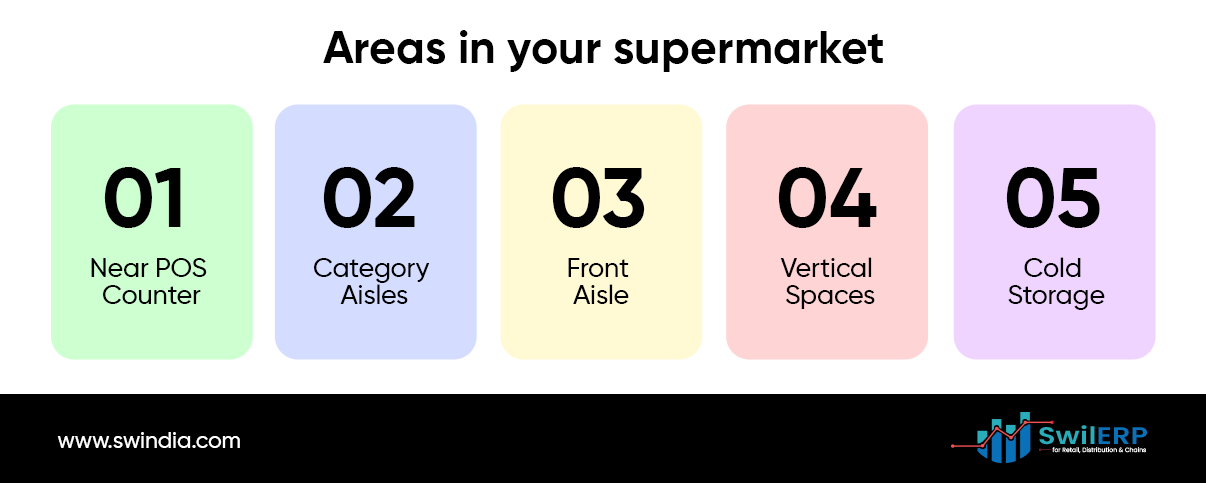
- Near POS Counter
- Category Aisles
- Front Aisle
- Vertical Spaces
- Cold Storage
Now that we’ve covered the basics, let’s dive deeper into some key areas that can make a big difference in how you place your inventory.
Ease of Finding Products
Customers should be able to locate items quickly and easily. This means logically organizing your store. Group similar products together, and use clear signs to indicate different sections. For example, all dairy products should be in one area, while fruits and vegetables should be in another. Here are some strategies to implement:
1. Group similar products together:
All dairy products should be in one area, while fruits and vegetables should be in another. This logical grouping helps customers find related items easily.
2. Use clear signage:
Implement large, visible signs to indicate different sections. Consider using both text and images to cater to different types of learners.
3. Create a store map:
Offer a simple map at the entrance or on shopping carts to help customers navigate your store.
4. Implement a consistent layout:
Keep your layout consistent across different store locations if you have multiple branches. This helps regular customers feel familiar with the store setup regardless of which location they visit.
5. Use color-coding:
Assign different colors to various sections of your store. This can help customers quickly identify and remember where different product categories are located.
6. Implement a logical flow:
Arrange products in a way that follows a natural shopping pattern. For example, place common ingredients for a meal close together.
7. Use end-cap displays effectively:
Highlight popular or seasonal items at the ends of aisles to catch customers’ attention and remind them of items they might need.
8. Proper Labeling:
Use clear, consistent labeling throughout your store. This includes shelf labels, category signs, and price tags. Good labeling helps both customers and staff quickly find and identify products.
9. Shelf ID Management:
Develop a system for identifying each shelf or section in your store. This could be a combination of numbers and letters. For example, aisle 1, shelf A. This system helps staff quickly locate and restock items.
10. Price Visibility :
Make sure price tags are clear and easy to read. While price isn’t always the most important factor for all customers, it should be readily available information.
Read Also: What is the Difference Between a Hypermarket and Supermarket?
Creating an Intuitive Layout
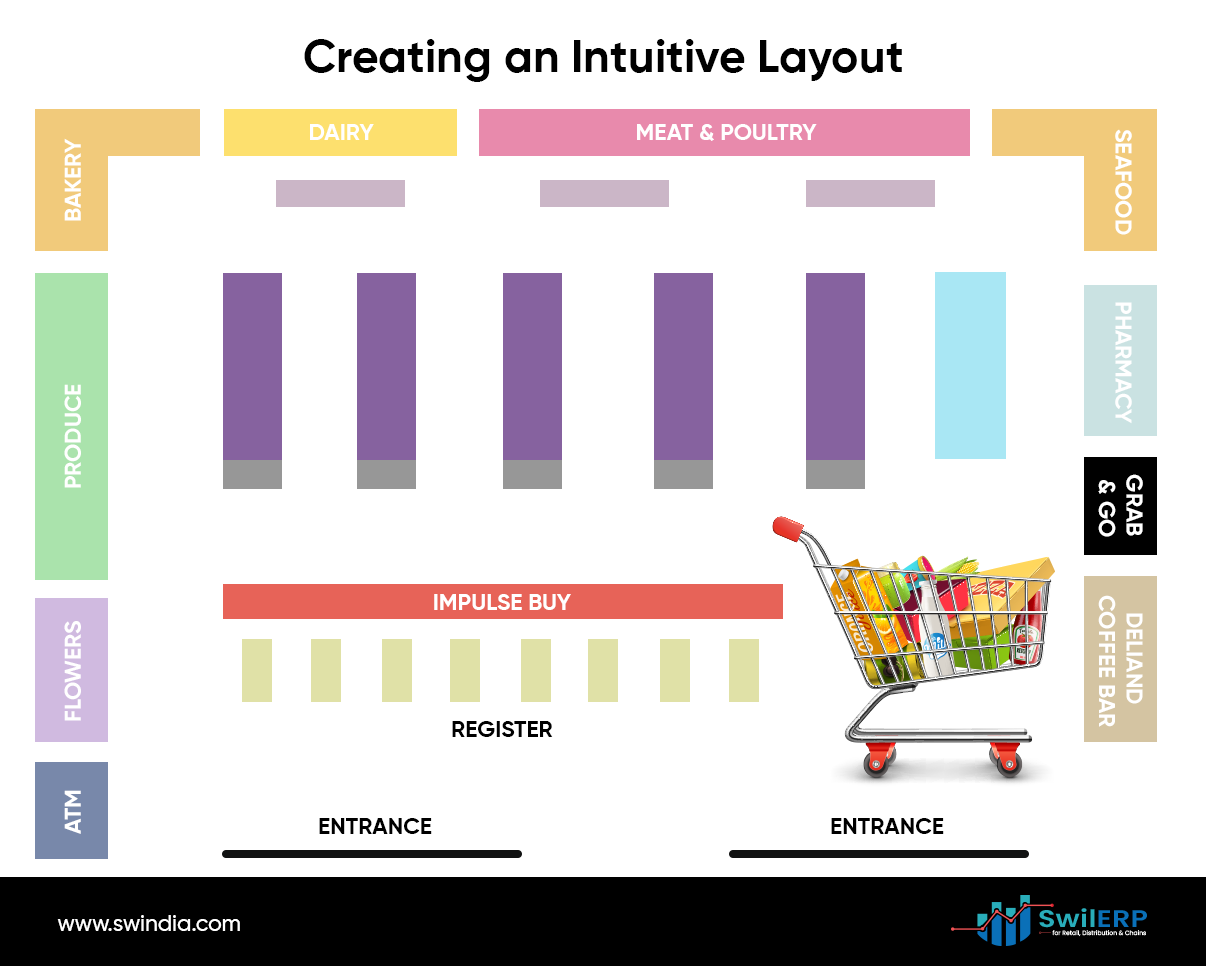
Think about the natural flow of customers through your store. Most people tend to move from left to right and prefer to walk counterclockwise. Use this knowledge to guide your layout. Place essential items like bread and milk towards the back of the store to encourage customers to walk through other sections.
Inventory Location Management: Importance of bulk and rack
Find a balance between bulk storage and shelf display. Have a separate area for bulk storage and keep an appropriate amount of each product on the shelves. This makes restocking easier and ensures products are always available for customers.
Using Vertical Space Effectively
Don’t just think in terms of floor space. Use your vertical space wisely, too. Place popular items at eye level, where they’re easy to spot and reach. Less popular or higher-margin items can go on higher or lower shelves.
Visually Appealing Inventory
Products should be displayed attractively to make selection easier for customers. Clean, well-lit shelves and color coordination improve visibility and organization. Facing products forward and using risers adds interest. Rotating seasonal displays keeps the store fresh. Proper spacing prevents overcrowding, while planograms maintain consistency. Strategic lighting and display stand to highlight key items and create focal points.
Store Functionality: Make it easy to use.
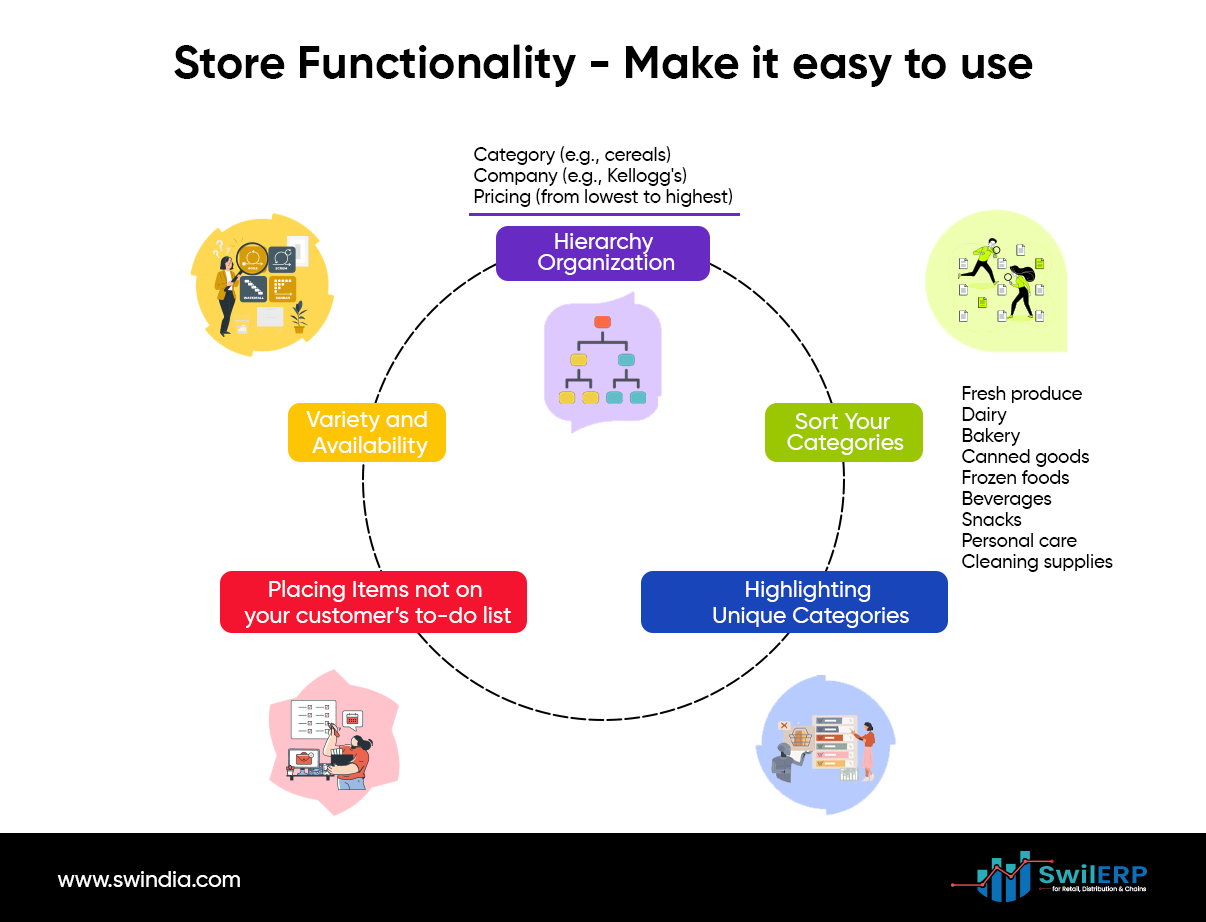
Hierarchy Organization
Organize your inventory in a clear hierarchy:
- Category (e.g., cereals)
- Company (e.g., Kellogg’s)
- Pricing (from lowest to highest)
This structure makes it easier for staff to manage inventory and for customers to find what they’re looking for.
Sort Your Categories
Start by listing all the product categories in your store. Common categories include:
- Fresh produce
- Dairy
- Bakery
- Canned goods
- Frozen foods
- Beverages
- Snacks
- Personal care
- Cleaning supplies
Highlighting Unique Categories
If your supermarket offers products that aren’t commonly found in other stores, make sure to highlight these sections. This can set you apart from competitors and attract customers looking for specialty items.
Placing items not on your customer’s to-do list
Place small, often-forgotten items near the checkout counters. These could include candy, magazines, or small personal care items. Many customers make last-minute purchases while waiting in line, which can boost your sales.
Variety and Availability
Offer a good range of products in each category. This gives customers choices and increases the likelihood that they’ll find what they’re looking for. Make sure popular items are always in stock and easily visible.
Ease of Carrying Goods
- Placing heavier items lower on shelves—let them use their back strength.
Consider how customers will carry their chosen items. Place heavier products at lower levels so they’re easier to lift into carts. Lighter items can go on higher shelves.
- Let them stroll the store with carts.
Walmart’s most expensive cart was $70,000; well, that’s not every day, but you can have higher per-customer invoicing if you make it easy for them to go around the store and carry their order with them until they are ready. Customers tend to shop more when this happens.
- No one likes waiting in line anymore—Quick Billing
Arrange products near the checkout counters in a way that makes scanning and bagging quick and easy. This helps reduce waiting times and improves the overall shopping experience.
- Make it easy to pay you. Multiple payment options are a must today.
While not directly related to inventory placement, offering various payment methods at the billing counters can greatly improve customer satisfaction. Ensure your staff is trained to handle different types of transactions efficiently.
Understanding Customer Behavior
Different customers have different priorities. Some are more concerned about price, while others focus on quality. Arrange your products to cater to these different groups. For example, you might organize items from left to right, with cheaper options on the left and premium brands on the right. This allows for easy comparison and caters to various customer preferences.
High-Margin Product Placement
Place products with higher profit margins in prominent positions. These could be at eye level on shelves or in high-traffic areas of the store. However, be careful not to overdo this at the expense of customer convenience.
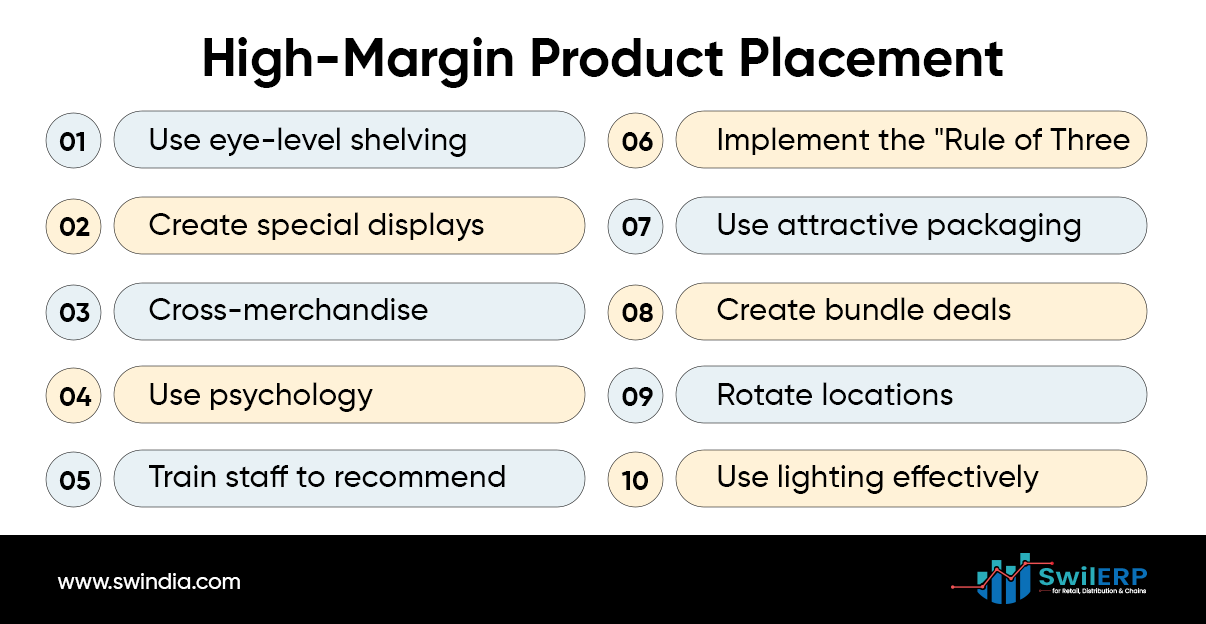
Strategic placement of high-margin products can significantly impact your bottom line.
- Use eye-level shelving: Place high-margin items at eye level where they’re most likely to be seen and purchased.
- Create special displays: Use standalone displays or end caps to highlight high-margin products.
- Cross-merchandise: Place high-margin items near related products with lower margins to encourage additional purchases.
- Use psychology: Place high-margin items to the right of lower-margin alternatives, as people tend to scan from left to right.
- Train staff to recommend: Educate your team about high-margin products so they can suggest them to customers when appropriate.
- Implement the “Rule of Three”: Display high-margin products in groups of three, as consumers tend to gravitate towards the middle option.
- Use attractive packaging: Ensure high-margin products have appealing packaging that stands out on the shelf.
- Create bundle deals: Pair high-margin items with complementary products to increase their visibility and sales.
- Rotate locations: Periodically change the location of high-margin products to catch the attention of regular customers.
- Use lighting effectively: Highlight high-margin products with spotlighting to draw customer attention.
Placing Products with Short Shelf Life
Proper management of perishable items reduces waste and maintains profitability. Placing products with shorter expiry dates in visible locations ensures they sell first. FIFO helps older stock sell before newer items. Clear date labeling and discounted areas for soon-to-expire goods are useful. Technology can track expiry dates and alert staff for stock rotation. Proper refrigeration, just-in-time ordering, and training employees on handling perishables extend product life and minimize waste.
Advanced Learnings
Implementing Cross-Merchandising
Place complementary products near each other. For example, put pasta sauce next to pasta or salad dressings near the fresh produce. This can remind customers of items they need and increase sales.
Seasonal Fluctuations
Create flexible spaces in your store that can be adapted for seasonal products. This allows you to highlight holiday items or summer essentials without disrupting your regular layout.
Creating Themed Displays
Use special displays or end caps (the ends of aisles) to highlight seasonal items or special promotions. These can draw customer attention and boost sales of featured products.
Adjusting for Store Traffic Patterns
Pay attention to which areas of your store get the most foot traffic. These high-traffic areas are prime locations for promotional displays or high-margin items.
General To-Dos
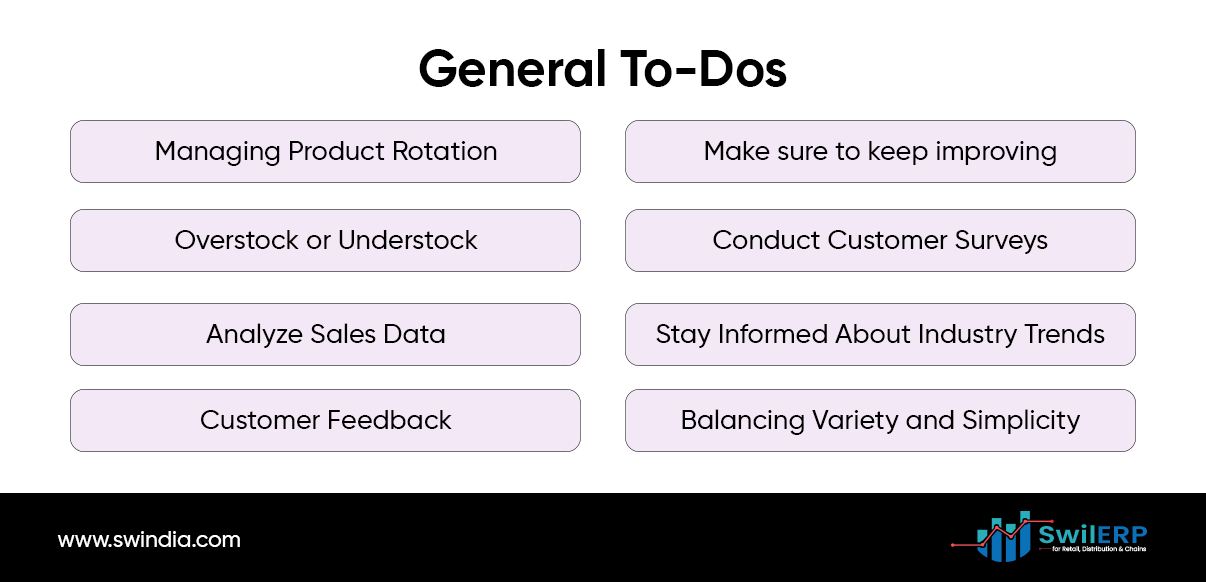
Managing Product Rotation
Implement a “first in, first out” (FIFO) system for stocking shelves. This means placing newer products behind older ones to ensure that older stock sells first. This is especially important for perishable items.
Overstock or Understock
Regular inventory checks and good communication between sales floor staff and the purchasing team can help prevent overstock or under-stock situations.
Analyze Sales Data
Regularly review your sales data. Which products are selling well? Which aren’t moving as expected? Make adjustments to your placement approach based on this knowledge.
Customer Feedback
Pay attention to customer comments and complaints. If many customers have trouble finding a particular item, consider adjusting its placement.
Make sure to keep improving
Your inventory placement strategy shouldn’t be static. Continual assessment and modification are essential to keeping a system functional. Here are some ways to keep your strategy up-to-date:
Conduct customer surveys.
Ask your customers for feedback. What aspects of your store’s layout appeal to them? What would they alter? This direct feedback can be very beneficial.
Stay Informed About Industry Trends
Keep up with trends in supermarket management and retail psychology. Recent studies may provide information that could help you better arrange your inventory.
Balancing variety and simplicity
While offering variety is important, too many choices can overwhelm customers. Strike a balance by offering a good selection without overcrowding your shelves.
Common Challenges and Solutions
Even with careful planning, you may encounter some challenges in inventory placement. Here are some common issues and how to address them:
Limited Space
If your store has limited space, focus on efficient use of vertical space and consider using mobile shelving units that can be moved as needed.
Train Your Staff

Make sure your staff understands the reasoning behind your inventory placement. Drawing from their customer experiences, they can offer insightful comments and recommendations.
Using Technology
Now, let’s talk about how technology can make your warehouse work better. SwilERP makes your warehouse work better. It’s like having a smart helper that knows where everything is and how much you have. When you’re running low on something, SwilERP will let you know so you can order more. It’s also great at figuring out where to put things on your shelves – it’ll suggest spots that make sense based on how often you need each item. When it’s time to gather items for an order, SwilERP can show your workers the quickest way to get everything. And if you use barcodes or QR codes with it, you can easily keep track of what’s coming in and going out just by scanning. It’s a simple way to make your warehouse run more smoothly.
Conclusion
Effective inventory placement in a supermarket is a complex task that requires careful planning and ongoing management. You may design a retail layout that benefits both your bottom line and your customer’s experience by putting equal emphasis on operational effectiveness and customer experience.
Remember, the key to success is to start with a solid plan, implement it carefully, and be willing to make adjustments as you learn what works best for your unique store and customer base. With patience and persistence, you can create an inventory placement strategy that sets your supermarket apart.









